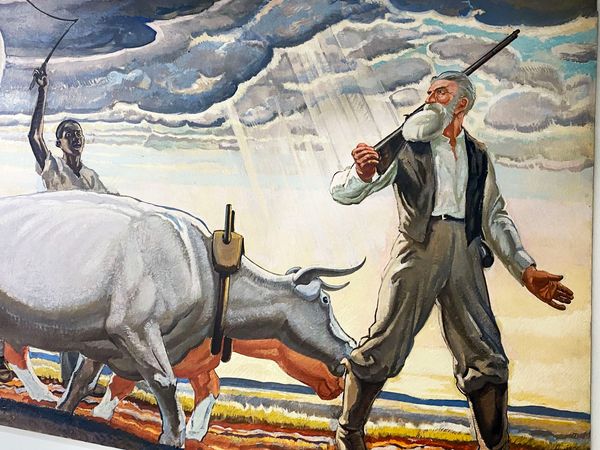(Subscribe to The Brass File to get it e-mailed free to your in-box by clicking on the link at the bottom of this page. Thank you.)
Story By John Murray
John Brown was the first person executed for treason in the United States, and now 162 years after his raid at Harpers Ferry tried and failed to incite a slave rebellion, community leaders in Torrington, Connecticut – Brown’s birthplace – are calling for a statue to be erected in his honor.

John Brown is one of the most important and controversial figures in American history. |
“I would like to see a 50-foot-tall statue of John Brown in Torrington with one foot on the west bank of the Naugatuck River and his other foot on the east bank,” Mark Linehan said to a small group of Brown enthusiasts gathered on December 5th, on John Brown Road in Torrington. “It should be lit up at night with a chain bridge connecting the two sides. We should call it the Freedom Bridge.”
Linehan is a founder of the Torrington Trails Network and was addressing two dozen people gathered at the John Brown property, where the famed abolitionist’s home once stood (it burned down in 1918). Every year in early December (around the anniversary date of Brown’s execution, December 2nd, 1859) a hike across the property is organized to honor Brown and his historic and controversial fight to end slavery in America.
Brown was described by Robert E. Lee, who captured him at Harpers Ferry, as a “fanatic or madman” who was doomed to failure. But Linehan told the gathering that Brown’s efforts to end slavery have always been held in high regard by America’s Black population, including author W.E.B. Du Bois, who in 1906 led a group of barefoot pilgrims on a spiritual walk to the site of the insurrection.
John Brown is one of the most controversial figures in American history and even today questions linger; was Brown a fanatic, a hero who died for a noble cause, a martyr, or a terrorist? 162 years after his death, John Brown remains a catalyst to discuss the subject of slavery and the use of violence to achieve political and social change. The debate swirls around his use of violence for what is now viewed as a noble goal, ending slavery. In 1859, however, the country was divided on the issue of slavery, and Brown’s raid at Harpers Ferry is often described as the spark that ignited the Civil War, the bloodiest conflict in American history.
On a website run by the National Park Service at Harpers Ferry it states that, “The Harpers Ferry invasion advanced the cause of disunion more than any other event that has happened since the formation of the government.”
John Brown’s raid at Harpers Ferry splintered northern and southern Democrats and paved the way for a Republican candidate to capture the White House in 1860; his name was Abraham Lincoln.
While many whites in the North were in favor of abolishing slavery, a far smaller number were in favor of equal rights for Blacks.
“Lincoln struggled with this issue, and Thoreau struggled with this too,” Linehan said in the fading daylight on December 5th, “but for John Brown there was no debate. He wanted to end slavery and allow blacks and whites to live together as equals. He has been described as the least racist person of his time.”

Mark Linehan has called for a massive 50-foot statue to be erected in Torrington. |
Now, in a time when statues are being re-interpreted and torn down, Linehan’s call for building a massive statue of John Brown straddling the Naugatuck River in downtown Torrington is breathtaking. The Brown birthplace is on the seal of Torrington, which is on the sides every police car and all the blue trash barrels handed out to residents. Linehan and a group of community leaders want more.
“Torrington should be incredibly proud that John Brown was born here,” Linehan said, “and we should build a statue.”

The old Brown homestead in Torrington was destroyed by fire in 1918. |
There are many historians who dismiss John Brown as a zealot or a nut, but to many Black Americans, he is the finest white man to ever walk on American soil. Comedian and civil rights activist Dick Gregory called John Brown the greatest American who ever lived, and Malcolm X was once asked in an interview whether he would accept whites into the organization he’d founded, said no, but after a moment of contemplation said, “If John Brown were still alive, we might accept him.”
Not sure who John Brown was? Buckle up, here is a brief account of his life, and his considerable impact on American history.
Brown was born May, 9th, 1800 in Torrington, Connecticut. Brown only spent the first five years of his life in Torrington before his father, Own, a tanner, uprooted the family and moved to the Western Reserve of Connecticut, in what is now Hudson, Ohio. Brown was a direct descendent of Peter Brown, who arrived in Massachusetts on the Mayflower in 1620. Brown’s grandfather, Captain John Brown, was killed in 1776 during the Revolutionary War. Brown’s family were Calvanists and strongly opposed to slavery.
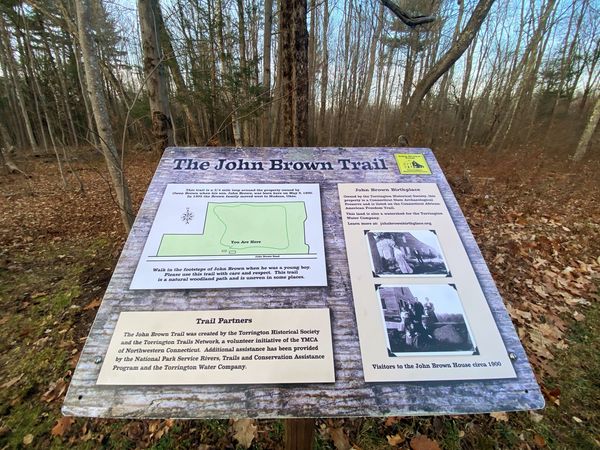
A trail has been created around the Brown property in Torrington. |
Brown moved around a lot in his life living in Connecticut, Ohio, Massachusetts, New York, Pennsylvania and Kansas. He studied for a short time at the Morris Academy in Litchfield (now Morris, CT), and was an unsuccessful farmer, tanner and businessman, and eventually went bankrupt.
One constant throughout his life was a fierce opposition to slavery. The Hartford Courant reported that Brown wrote a third-person autobiography that recalled 12-year-old Brown witnessing a black boy beaten with a shovel. He wrote…
“This brought John to reflect on the wretched, hopeless condition, of Fatherless & Motherless slave children: for such children have neither Fathers or Mothers to protect & provide for them. He sometimes would raise the question is God their Father?”
In 1837, following the murder of an anti-slavery activist and newspaper publisher, Elijah Lovejoy, Brown stood up in church and declared before God and witnesses that, “I consecrate my life to the destruction of slavery.”

A hero or a terrorist? The debate about John Brown continues to this day. |
In the 1830s Brown owned a farm in Pennsylvania that was part of the Underground Railroad and provided a safe house for 2500 slaves making their way north to Canada. In the 1840s Brown moved to Massachusetts where he met Frederick Douglass and Sojourner Truth and began a 20-year plan to ignite a slave rebellion in the South.
Brown was a religious man who believed that God had chosen him to lead the slave rebellion, and after decades of non-violence, he ultimately concluded that violence was the only way to achieve that goal. In the 1850s four of his sons moved west to help determine whether the Kansas Territory would become a free state, or a slave state. The outcome would determine which side controlled the U.S. Senate and the debate turned violent. Brown’s son wrote to him and asked that he deliver weapons to help the cause, and he did.
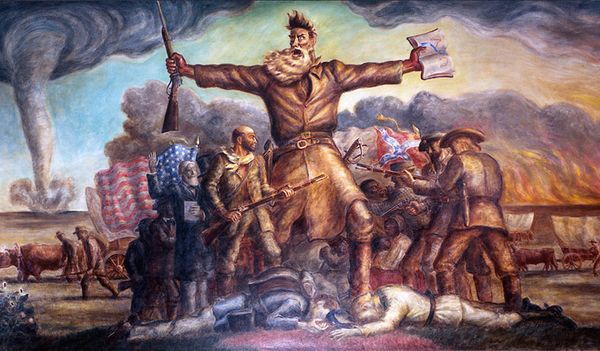
Tragic Prelude by John Curry is displayed inside the Kansas Statehouse. |
The two sides battled over slavery (a precursor to the Civil War), and when pro-slavery guerillas murdered pro-abolitionists, Brown and his sons retaliated and dragged pro-slavery settlers out of their homes and hacked five men to death with swords. The incident became known as the Pottawatomie Massacre. Frederick Douglass described the attack as “a terrible remedy for a terrible malady”, but the event elevated John Brown to national attention, and to many people he was an abolitionist hero.

John Brown and Frederick Douglass were friends, and leading abolitionists in the 1850s. |
After the massacre Brown traveled through the Northeast for the next three years raising money and collecting weapons for the insurrection he was plotting. He was intent on raiding the southern states to free and arm the slaves for a rebellion that would end slavery for good.
During a sweep through Connecticut in 1857, where Brown had many friends, he spoke in Canton, Hartford and Collinsville. While in Collinsville he ordered 1000 spear-like weapons called pikes from the Collins Company, weapons he planned to arm slaves with for their fight for freedom.
His plan ultimately brought him to Harpers Ferry, Virginia, in 1859, where he led a group of 21 men in capturing a federal armory. He captured the armory, but Brown’s vision of thousands of slaves swarming to the rebellion never materialized, and the revolution was quashed in 48 hours by federal troops led by Robert E. Lee. In the battle Brown was bludgeoned unconscious and captured, and the majority of his 21-man army was killed, including two of his sons. Brown had hoped thousands of slaves would join the insurrection, but he had miscalculated.
Brown was charged with murder and treason against Virginia, and after a quick trial he was executed by hanging. In the six-week period between his capture and execution Brown was the talk of the country. His use of violence was controversial among abolitionists, but on the day of his hanging Brown wrote, “I John Brown am now quite certain that the crimes of this guilty land will never be purged away, but with Blood.”
Henry David Thoreau wrote, “A Plea for Captain John Brown”, on October 30, 1859. “I am here to plead his cause with you. I plead not for his life, but for his character,–his immortal life; and so it becomes your cause wholly, and is not his in the least. Some eighteen hundred years ago Christ was crucified; this morning, perchance, Captain Brown was hung. These are the two ends of a chain which is not without its links. He is not Old Brown any longer; he is an angel of light.”
Some newspapers described the raid on Harpers Ferry as the act of a madman. Harvard historian John Stauffer wrote, “Brown was thought mad because he crossed the line of permissible dissent. He was willing to sacrifice his life for the cause of blacks, and for this, in a culture that was simply marinated in racism, he was called mad.”
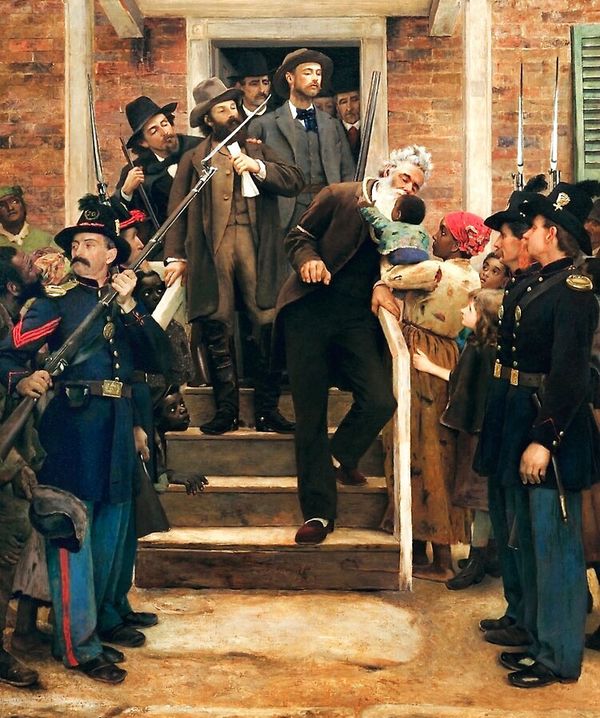
Painting of the final moments in John Brown’s life by Thomas Hovenden |
The institutions of slavery could kill John Brown, but they could not answer his cries for justice. At an event held in Harpers Ferry in 1881, Frederick Douglass said, “If John Brown did not end the war that ended slavery, he did at least begin the war that ended slavery.”
Douglass had opposed the raid at Harpers Ferry, but was a close confidante of Brown and prosecutors had sought to arrest him as an accomplice after the raid. Even though the raid failed to launch a slave rebellion, Douglass admire Brown for his commitment. In a speech in 1881 Douglass honored the memory of John Brown.
“The true question is; did John Brown draw his sword against slavery and thereby lose his life in vain? And to this I answer ten thousand times, No! No man fails, or can fail, who so grandly gives himself and all he has to a righteous cause. No man, who in his hour of extremest need, when on his way to meet an ignominious death, could so forget himself as to stop and kiss a little child, one of the hated race for whom he was about to die, could by any possibility fail.”
Abraham Lincoln was opposed to Brown’s violent tactics at Harpers Ferry, but in the Civil War he was ultimately forced to execute what he called, “a John Brown raid on a gigantic scale”.
Ironically, Union soldiers marched into battle during the Civil War singing a hymn entitled, “John Brown’s Body”, that portrayed him as a heroic martyr. But after the war, besides African Americans who still revered him, John Brown was largely written off as a kook until the Civil Rights movement in the 1950s and 1960s, when his deeds were reconsidered.
Mark McEachern is the executive director of the Torrington Historical Society, the shepherd of the John Brown birthplace property, and said it is the ongoing debate about race relations in America that keeps John Brown relevant today.
“This is why John Brown is so interesting.” McEachern said. “He makes us think about thorny issues of the past, and thorny issues of today.”

Mark McEachern is the executive director of the Torrington Historical Society |
McEachern, who has spent decades researching John Brown, said there are “probably more books written about John Brown than any figure in American history, besides Abraham Lincoln.”
On December 5th McEachern carried a lantern through the woods as he guided hikers around the 2/3-mile loop of the John Brown property in Torrington. As he walked, swinging the lantern back and forth through dusk, McEachern shared local stories about Brown.
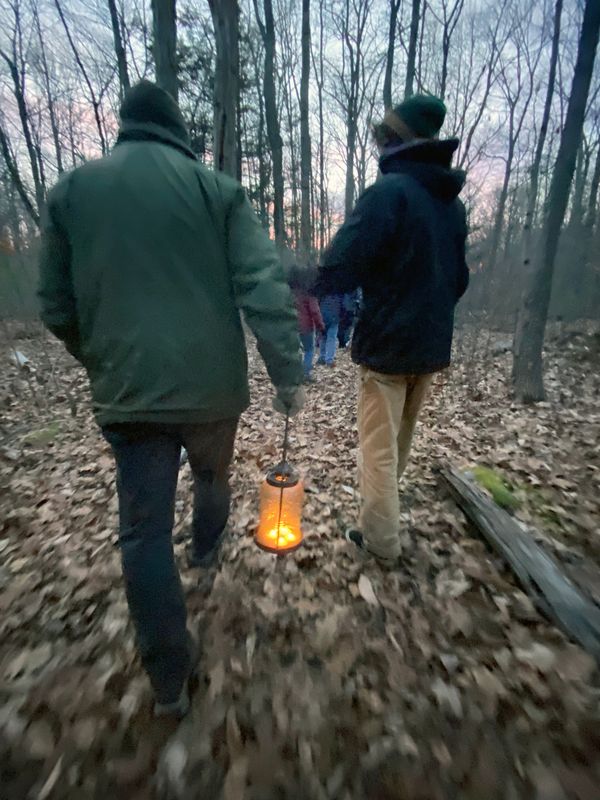
Mark McEachern guiding hikers across the Brown property with a lantern. |
“John Brown for executed for treason in 1859, and yet in 1957 three murals were painted inside the Torrington Post Office honoring Brown,” McEachern said. “The Post Office is operated by the U.S. government, the one that had executed him 100 years before.”
McEachern said there are tourists and pilgrims that make their way to Torrington to celebrate John Brown, and that Brown’s birthplace is part of the Connecticut Freedom Trail. The property was owned by the John Brown Society for nearly 100 years until it merged with the Torrington Historical Society, which acquired the property.

The John Brown mural by Arthur Covey is displayed at the Torrington Post Office. |
The Torrington Historical Society organized a John Brown Symposium in the 1990s around the time Los Angeles exploded in violence after Los Angeles police officers were acquitted by a jury of beating Rodney King, a black man, almost to death.
“The lesson was that racial inequality that is allowed to go on and on builds up hate and frustration,” McEachern said, “and that results in violence.”
As darkness fell along John Brown Road the hikers emerged from the forest and celebrated by eating fudge John Brownies, a specialty treat made for the occasion by a bakery in downtown Torrington.
With the annual John Brown hike ending, McEachern, standing next to the foundation of the old Brown homestead, recalled the first known pilgrim that arrived at the property, and she arrived on December 2nd, 1859, the day the abolitionist was executed.
Sarah Prichard was a literary writer and historian from Waterbury, Connecticut, twenty miles south of Torrington, and on the day Brown was hanged in Virginia she traveled north to Torrington.
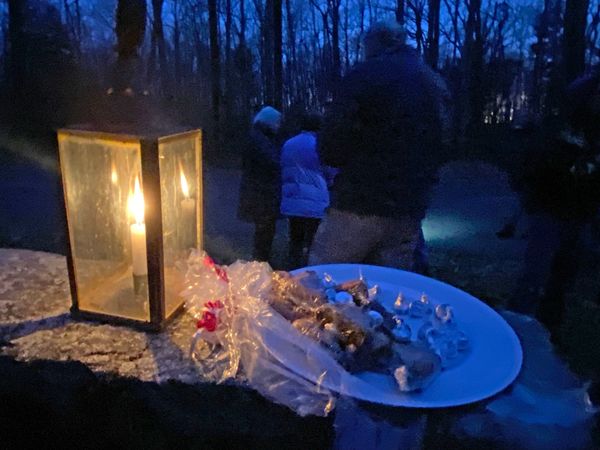
John Brownies awaited hikers at the end of the walk around the Brown homestead. |
“Sarah Prichard took a train from Waterbury and then took a horse and carriage out here and knocked on the door,” McEachen said “At the time of his execution she wanted to be in his house, and she was in the attic when he was executed.”
The Torrington Historical Society now has a dual mission to preserve history and the memory of John Brown. So, does Mark McEachern share the same vision of a 50-foot statue of John Brown straddling the Naugatuck River in downtown Torrington?
“Today is the first I heard about that specific idea,” McEachern said. “I agree with Mark Linehan that there should be a statue of John Brown in downtown Torrington, and it should be something physical for people to gather around.” •
Check out two other stories in the Observer’s John Brown package at…

